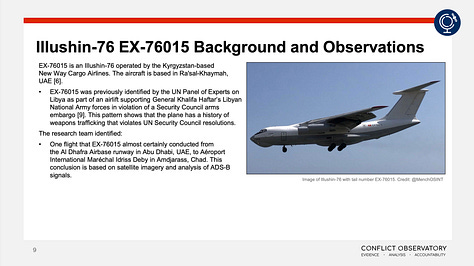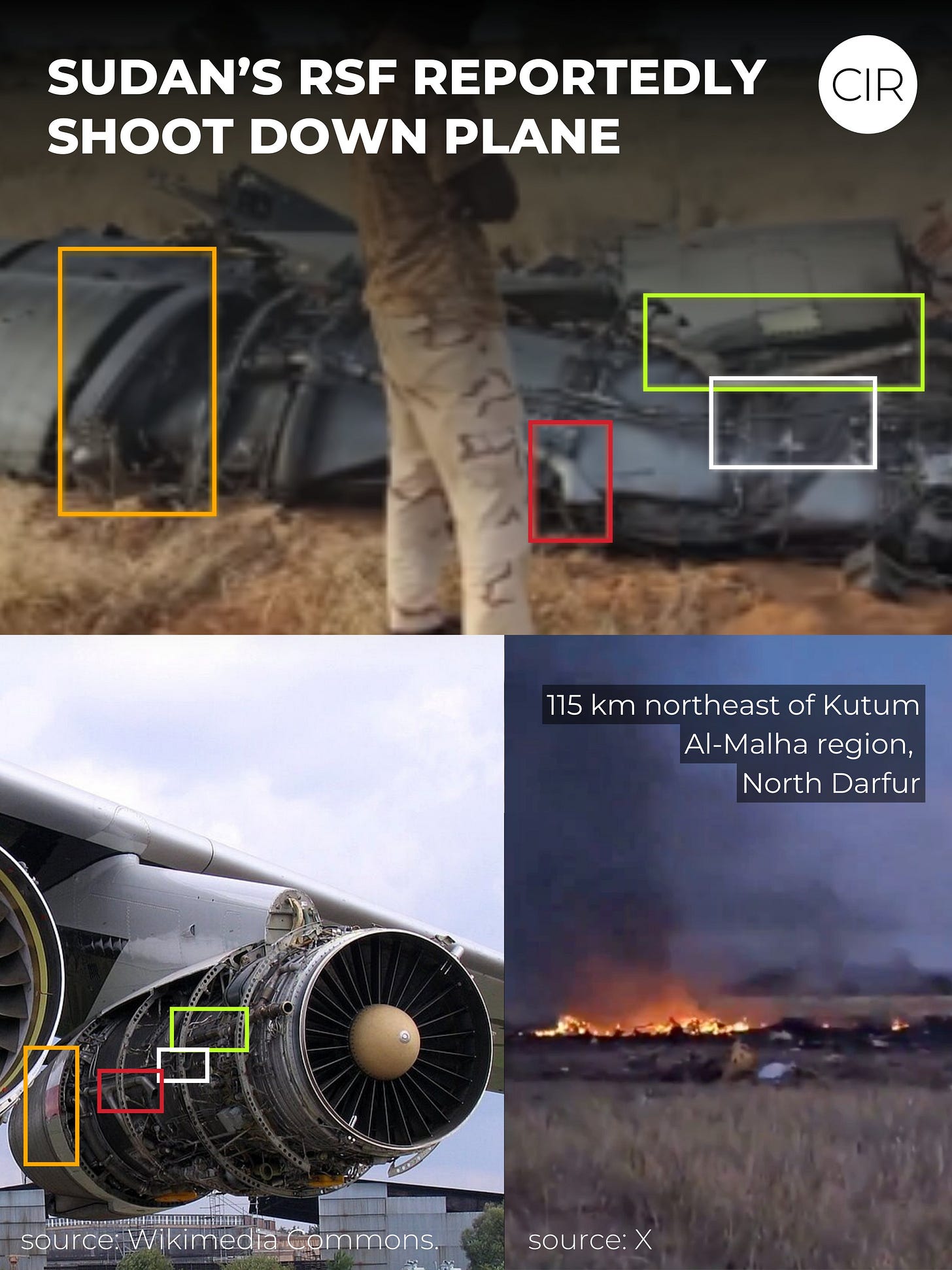Mercenary aviation: Russian cargo planes helped both sides in Sudan's war
Crew of downed plane had ties with infamous arms dealer Victor Bout
Five days ago on the scrubland of North Darfur, at the edge of the Sahara Desert, a Soviet cargo aircraft crashed and burst into a ball of fire, leaving no survivors. Items recovered from the wreckage, including identity documents, indicated that the airplane and its crew had ties to Russia, Kyrgyzstan, and the United Emirates (UAE).
In an article published within hours of this crash, we identified the downed airplane as a “UAE cargo plane.” The article further suggested that the airplane, identified as an Ilyushin-76 (IL-76), was part of an airlift sponsored by the UAE in support of the Rapid Support Forces (RSF), an armed group battling the Sudanese military.
This assertion was incorrect, and we hereby retract the article in part.
While it is true that the airplane previously was operated by a company involved in a UAE airlift to Amdjarass, Chad, allegedly in support of the RSF, it was not flying on behalf of the UAE or the RSF at the time of the crash.
Subsequent reports by other news organizations, including Reuters and Sudanese newspapers, as well as our own follow-up research, indicate that the airplane instead was operating in support of the Sudanese Armed Forces (SAF).
Reuters reported that the plane “seems to have supplied both sides at different times.” In a report published Wednesday, the news agency explained:
“Flight tracking data and information from social media accounts… suggest the transport plane switched months ago from supplying the RSF to the army. A Reuters analysis of the documents, footage and social media indicate at least one of the Russian crew had a past in arms trafficking.
“…One of the suspected crew members is Victor Granov, 67, whose work ID, South African driver's license and expired passport were found in the wreckage, according to footage provided by the RSF. Information from a LinkedIn account and Russian court records show him living in South Africa.
“A 2005 report by rights group Amnesty identifies Granov as a South Africa-based businessman formerly associated with Victor Bout, a notorious arms dealer released in a prisoner swap between Russia and the U.S. in 2022.
“According to the report, Granov ran two airlines accused of violating an arms embargo in the Democratic Republic of Congo.
“Among the photos of documents circulating online and in some media after the plane was downed was a set of safety instructions showing the registration number EX-76011.
“EX-76011 is the number of an IL-76 previously operated by New Way Cargo, an airline identified as supplying the RSF via Chad with backing from the United Arab Emirates, according to a report this month from the Sudan Conflict Observatory, a monitoring platform funded by the U.S. State Department…
“However, the last available data for the plane, from December 2023, show it flying to Port Sudan on the Red Sea coast, the de facto headquarters of the army.
“Information from Swiss intelligence provider ch-aviation shows EX-76011 was operated by New Way Cargo, an airline based in Bishkek, Kyrgyzstan, and managed by Astraway FZC, a UAE-based aviation service company.
“Kyrgyzstan's civil aviation agency told Reuters the plane was removed from its register and transferred to Sudan on Jan. 12 this year. Astraway FZC said it stopped working with EX-76011 and its crew in December 2023.
Additionally, items found on board the plane, such as water bottles and money, corroborate the finding that the aircraft was based in Sudan, and no longer in the UAE.






According to an independent Dutch aviation analyst, who preferred not to be named, the IL-76 recently had changed its registration from EX-76011 to ST-JAN. He said the aircraft was deregistered from the Kyrgyz register in early January 2024. The last available flight data on the airplane was from December 2023, when the airplane flew from Agaba in Jordan to Port Sudan, a city under control of the Sudanese military.
The analyst concluded, “The aircraft was operating for the Sudan military, supplying weapons to the military in the neighborhood of the El Fasher airport. It could be the aircraft landed there or airdropped its load. The IL-76 has a loading deck which can be opened in flight to drop cargo. On the way back from El Fasher heading north to an unknown destination the aircraft was downed.”
El Fasher is partly controlled by the Rapid Support Forces, which means any landing at the airport there would have been very dangerous. An airdrop of supplies (using parachutes) would have been safer. There are previous confirmed reports of airdrops over the city.
Mohamed Khalifa, an analyst specializing in military affairs, said, “The plane that crashed in the Malha area belongs to the Sudanese military. It is of the Ilyushin type and is one of two that the military recently brought from abroad… the plane took off from Port Sudan towards El Fasher on an official mission. It was an airdrop mission for the 6th Infantry Division, and the plane carried weapons, ammunition, and medicine.
Khalifa, who supports the Sudanese army rather than the RSF, added,
“The plane completed its mission successfully and made a very successful airdrop. But on its way back it started burning in the sky and crashed. The reason for the crash is unknown so far, it is likely that there was a technical malfunction, or it was targeted, and this is a possibility but a weak one.”
Sudanese media reported that three Sudanese nationals were among the dead on board the aircraft, in addition to two Russians. The standard crew of an IL-76 is five.
The RSF have besieged the North Darfur capital since April, cutting it off from other army-controlled areas elsewhere in the country. This has made it difficult for army and allied Joint Force troops there to obtain weapons, food, medical supplies, and ammunition, necessitating the airlift.
El Fasher recently suffered heavy damage due to heavy bombardment by SAF warplanes and artillery. A new report by the Yale Humanitarian Research Laboratory detailed evidence of the damage caused by these attacks.
According to the aviation analyst, the IL-76 is capable of dropping bombs, but he doubted that the downed Russian airplane was involved in the attacks on El Fasher. The analyst told Sudan War Monitor, “I understand Sudanese Air Force still have a lot operational fighter jets. So bombing by these jets is far more likely than pushing bombs out of a large, fragile, slow-flying IL-76.”
Meanwhile, analysts from the Centre for Information Resilience geolocated videos of the crash site to an area 115 km northeast of Kutum in the Malha area of North Darfur. They further analyzed the wreckage to confirm the type of aircraft, an IL-76.

According to the Associated Press, authorities in Kyrgyzstan have disavowed any ongoing connection with the airplane:
“A crumpled safety card, also purportedly from the aircraft, identified the plane as flown by New Way Cargo of Kyrgyzstan. However, Zuurakan Kadyrova of New Way Cargo told The Associated Press on Tuesday that her firm’s lease of the aircraft expired at the end of 2023.”
“Since that time, we have no records regarding the aircraft,” she said. “We are saddened by the news of the incident that occurred in Sudan and express our condolences to the crew and their families.”
Kyrgyzstan’s state-run Kabar news agency separately reported, citing the country’s Foreign Ministry, that the plane had been removed from its aircraft registry in January this year “and transferred to the registration of the Republic of Sudan.” No Kyrgyz nationals died in the crash, the report said.
According Kyrgyz authorities, the aircraft was sold to an Egyptian company, coinciding with its transfer to Sudan. However, the continued involvement of same Russian crew in the aircraft raise questions about this reported transaction. It is normal for airplanes involved in arms trafficking to use different legal entities to operate under, especially if they are simultaneously working for both sides in the same civil war—something they would want to hide.
Reuters suggested there are still unanswered questions about the supply networks involved in Sudan’s war, calling them “murky”:
“The incident offers a glimpse into the murky supply networks behind the more than 18-month war between Sudan's army and the Rapid Support Forces (RSF).”
Apology to readers
In conclusion, our report incorrectly stated that a downed aircraft in North Darfur “was part of an airlift sponsored by the United Arab Emirates in support of the RSF.”
We regret this error and sincerely apologize to our readers.
Since we began publishing last year, we have consistently provided a mix of factual reporting and subjective analysis of conflict events. This approach was intended to address a significant information gap about the military situation. Disinformation was (and still is) rife as both sides circulated outlandish claims, exaggerated their wins, covered up or downplayed their losses, produced fake maps of territorial gains, and circulated misleading or outdated videos.
Simultaneously, the open source environment provides a rich trove of potentially truthful and actionable information, if it can be filtered and deciphered. For more than a year, our team of analysts has waded into this morass of information and disinformation to try to bring greater clarity.
Given our interpretive approach, a certain number of mistakes is inevitable. For example, when we publish maps showing the areas of control by the warring parties, we usually indicate that the maps could be partially incorrect. Precision in such work is usually not possible, so we approach the task with a rigorous attitude but not a perfectionist one.
In this instance, the conclusions of our article were too hasty and too far-reaching, and the error was a serious one. Hence the need for a formal retraction and apology to our readers. For the sake of transparency, we have left the original article unedited but have inserted a notice to the article indicating that it was retracted.
News in Brief:
More than 100 villagers were killed in two villages in Al Jazeera State yesterday due to attacks or reprisal killings by the RSF. Details to follow.
Relief supplies provided by the aid agencies have reached Al Sereif and Atash displacement camps in South Darfur, according to a local leaders cited by Radio Dabanga. Two medical clinics were reopened in the camps.
Two UN agencies issued a joint statement Friday saying the famine threat in Sudan is growing, not diminishing, despite the start of the harvest season in the country: “An estimated 13 million people are facing acute levels of food insecurity. Fourteen regions across the country are teetering on the brink of famine, and in Zamzam camp in North Darfur, famine conditions have already been confirmed. There are 3.7 million children under five projected to suffer from severe acute malnutrition this year alone who are in urgent need of life-saving treatment. These children are already weakened by hunger. If not reached soon, these children are 11 times more likely to die from preventable diseases than their healthier peers inside Sudan.”
The United States Treasury Department announced sanctions against Mirghani Idris Suleiman, the weapons procurement director for the Sudanese Armed Forces (SAF). In a statement, the Treasury Department said, “Since the beginning of the war, the SAF has prioritized weapons acquisition, including Iranian drones and a port-for-weapons deal with Russia, choosing to expand the conflict rather than end it through good-faith negotiations. The weapons and diplomatic support provided by Iran and Russia have emboldened the SAF and lessened their interest in deescalating the conflict.”


